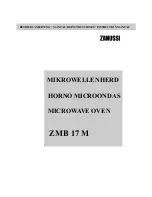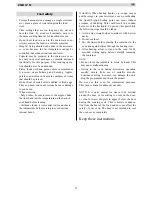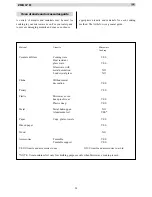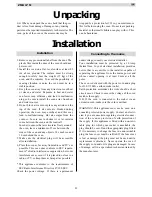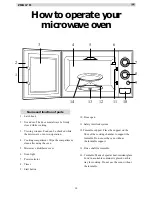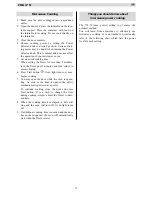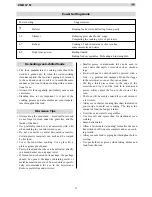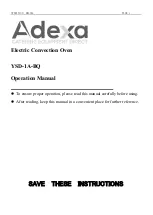
• The built-in safety interlock switches prevent the
microwave oven from operating when the door is
open Do not tamper with them, or attempt to operate
the oven with the door open as this could result in
exposure to microwave energy or cause damage
requiring repair by an authorised technician.
• Do not allow food spills or cleaner residue to accu-
mulate on door sealing surfaces. See the Cleaning
and Care section for cleaning instruc-tions.
• Do not operate the oven if it is damaged until it has
been repaired by qualified service personnel.
• It is particularly important that the oven door clo-
ses properly and that there is no damage to the:
(1) door (warped), (2) hinges and latches (broken
or insecure), (3) door seals and sealing surface.
• It is hazardous for anyone except factory trained
service personnel to service or make adjustments
to this oven. Contact your nearest authorised servi-
ce agent should service be required.
• Do not remove the outer case, door or control
panel at any time. Doing so may cause exposure
to extremely high voltage.
• Install or locate this oven only in accordance with
“INSTALLATION INSTRUCTIONS” found in
this manual.
• Use the appliance for its intended use as described
in this manual. Do not use corrosive chemicals in
this appliance. This type of oven is specifically
designed to heat, cook, or defrost food. It is not
designed for industrial or laboratory use neither for
commercial use. The manufacturer bears no res-
ponsibility in the case of umproper usage.
• Never operate the oven empty or without the turn-
table. If food or water is not present to absorb the
microwave energy, the magnetron tube can be
damaged.
• WARNING : Do not allow children to use the
microwave oven without supervision.
• Do not store this appliance outdoors. Do not use
this product near water.
• Do not attempt to dry clothing or newspapers in
the microwave oven. These items can ignite.
• Do not use the cavity for storage purposes. Do not
leave paper products, cooking utensils, or food in
the cavity when not in
• Most glass, glass ceramic and heat-resistant glass-
ware utensils are excellent for use in the microwave
oven. Before use, make sure that the containers are
appropriate for microwave usage. Although micro-
wave energy will not heat most glass and ceramic
items, these utensils can become hot as heat trans-
fers from the food to the container. The use of oven
gloves to remove dishes is recommended.
• Place the cookware in the microwave along with a
glass half full of water. Heat on 750 W (100%) for
one minute. If the cookware feels hot, you should
not use it. If it is just slightly warm, you can use it
for reheating but not for cooking. If the dish is room
temperature, it is suitable for microwave cooking.
• It is necessary to cover foods in most cases. They
will be tastier and your oven will stay cleaner.
However, be sure to remove the cap or lid before
cooking foods or heating liquids in a sealed bottle
or recipient.
• Paper napkins, wax paper, paper towels, plates,
cups, cartons, freezer wrap and cardboard are great
convenience utensils. Always be sure containers
are filled with food to absorb energy and thus
avoid the possibility of overheating.
• Many plastic dishes, cups, freezer containers and
plastic wraps may be used in the microwave oven.
Follow manufacturer’s instructions when using plas-
tics in the oven. Avoid using plastic utensils with foods
that have high fat or sugar content since these foods
reach high temperatures and could melt some plastics.
• Do not leave oven unattended, and check from
time to time when heating or cooking food in plas-
tic, paper or other combustible containers.
• If smoke is observed, keep door closed, switch the
oven off or disconnect oven until smoke stops.
• It is not advisable to use metal recipients, forks,
spoons or metal ties or staples for deep-freeze bags.
However, you can occasionally warm food packed
in shallow aluminium trays (max. 4cm) without the
lid. The heating time will be slightly longer. When
so doing, make sure that the tray is placed on the cen-
ter of the turntable and is never allowed to come into
contact with the metal walls or door of the appliance.
• Containers with restricted openings, such as bottles,
should not be used for microwave cooking.
• Use caution when removing a lid or cover from a
dish to avoid steam burns.
26
ZMB 17 M
t
Safety instructions
Utensil safety
Safety instructions

